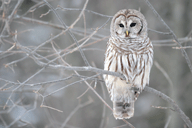
« PREVIOUS ENTRY
The joys of ‘porting: My latest Wired News video-gaming column

Behold the majestic Strix varia — otherwise known as the Barred Owl. Possessed of a three-and-a-half-foot wingspan and a particularly gnarly hoot, the Barred Owl historically was known to thrive only in old-growth forests. Why? Because it hunts by sitting on a branch and waiting for something to move, a technique that doesn’t work in a younger forest with smaller trees and dense, tall underbrush. It craves the cathedral-like openness of superold trees. And so back in the 60s and 70s, ornithologists feared that as old-growth forests across the US were cut down, the Barred Owl would eventually and tragically vanish.
But that hasn’t happened. The Barred Owl is thriving — because, interestingly, it has migrated to urban and suburban settings. Rob Bierregaard, an ornithologist at the University of North Carolina, had noticed that the suburbs of Charlotte were home to tons of Barred Owls. So he began a six-year-long study to ask the question: Why do Barred Owls thrive in the ‘burbs?
The answer, it turns out, is delightfully ironic: As far as the owls are concerned, the suburbs actually resemble old-growth forest. As Bierregaard puts it in this press release:
“When you look at suburban Charlotte, what do we have? We’ve got giant old willow oak trees with plenty of holes in them and we’ve got mowed lawns and azalea bushes, which is a very open understory, so they can see a long way. The habitat is an ‘uber’ old growth forest for owls because the understory is so open and there are plenty of birdfeeders to attract prey.”
Apparently, the only serious hazard the Charlotte owls face is the same one that threatens suburban humans: Automobiles. Collisions with cars are the leading cause of owl death. (Though it’s possible that cars are also helping to cull the owls, preventing the population from exploding and starving itself.)
I'm Clive Thompson, the author of Smarter Than You Think: How Technology is Changing Our Minds for the Better (Penguin Press). You can order the book now at Amazon, Barnes and Noble, Powells, Indiebound, or through your local bookstore! I'm also a contributing writer for the New York Times Magazine and a columnist for Wired magazine. Email is here or ping me via the antiquated form of AOL IM (pomeranian99).

ECHO
Erik Weissengruber
Vespaboy
Terri Senft
Tom Igoe
El Rey Del Art
Morgan Noel
Maura Johnston
Cori Eckert
Heather Gold
Andrew Hearst
Chris Allbritton
Bret Dawson
Michele Tepper
Sharyn November
Gail Jaitin
Barnaby Marshall
Frankly, I'd Rather Not
The Shifted Librarian
Ryan Bigge
Nick Denton
Howard Sherman's Nuggets
Serial Deviant
Ellen McDermott
Jeff Liu
Marc Kelsey
Chris Shieh
Iron Monkey
Diversions
Rob Toole
Donut Rock City
Ross Judson
Idle Words
J-Walk Blog
The Antic Muse
Tribblescape
Little Things
Jeff Heer
Abstract Dynamics
Snark Market
Plastic Bag
Sensory Impact
Incoming Signals
MemeFirst
MemoryCard
Majikthise
Ludonauts
Boing Boing
Slashdot
Atrios
Smart Mobs
Plastic
Ludology.org
The Feature
Gizmodo
game girl
Mindjack
Techdirt Wireless News
Corante Gaming blog
Corante Social Software blog
ECHO
SciTech Daily
Arts and Letters Daily
Textually.org
BlogPulse
Robots.net
Alan Reiter's Wireless Data Weblog
Brad DeLong
Viral Marketing Blog
Gameblogs
Slashdot Games